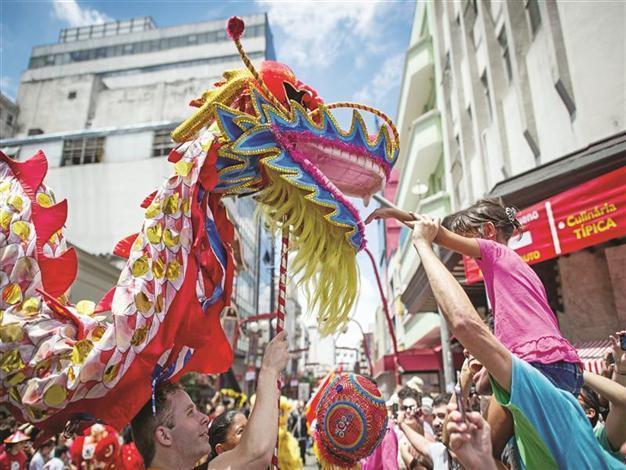Turkish mantı, Chinese mantou
Aylin Öney TAN

Chinese New Year is the first day of the new moon of the Chinese lunar year. AFP photo
This weekend is the start of Chinese New Year celebrations. The coming Year of the Water Snake will be welcomed by almost one fifth of the world’s population. The ancient Turkic calendar follows exactly the same pattern, so it is a snake year for Turks too. Let’s celebrate Chinese New Year with a Turkish twist!Chinese New Year is the first day of the new moon of the Chinese lunar year. The date usually falls between late January and late February in the western calendar. The New Year is celebrated as the Spring Festival, a period lasting two weeks until the first full moon of the first lunar month. The last day of Spring Festival is also known as the Lantern Festival and is a day for lovers.
In Chinese New Year celebrations, the symbolic significance of certain foods is very important. Bright, orange-colored citrus fruits like oranges, kumquats or tangerines represent wealth and good luck. Fish is cooked whole to maintain integrity and unity. Even if there cannot be any fish on the table in landlocked regions, at least a wooden fish statuette will be placed on the table to secure wholeness in the family. Green vegetables and spring onions stand for youthfulness. Sweet snacks guarantee a sweet year. Among all the foods, one of the most symbolic are noodles. Long – really long – noodles promise longevity. Dumplings bring luck, and if you’re lucky enough to find the hidden coin among dozens of Jiaozi dumplings, then you are sure to have a prosperous year. Dumplings in northern China are transformed into mantou, a form of steamed buns.
The connection between Turkish mantı and Chinese mantou is striking. There are many intriguing parallels between the food cultures of northern and western China and Turkey. One of the most significant dishes in all countries along the Silk Road, from the Sea of Japan to Anatolia, is dumplings. Dumplings across Asia are tell-tale signs of a shared common past demonstrating drastic similarities. From the Turkish perspective, the origins of mantı have been long forgotten and the dish is regarded as quintessentially Turkish. However, almost all etymological references state that the origin of the word comes from the Chinese word man tou. Etymological dictionaries of both Sevan Nişanyan and Hasan Eren point to a Mongol connection as well.
One of the earliest mentions of a dumpling similar to Turkish mantı is in the treatise written in 1330 by Hu Szu-hui, the Uyghur imperial doctor in service of the Chinese Emperor. The treatise, known as Yin-shan Cheng-yao (Proper and Essential Things for the Emperor’s Food and Drink), is a cross between a recipe book and manual for health. Translated into English as “Soup for the Qan,” the treatise includes three recipes that are clearly related to Turkish mantı. At the time the treatise was written, the borderless Mongolian rule “Pax Mongolica” was conducive to trade and travel, creating a multi-cultural atmosphere between many cultures of Asia, particularly Central Asian Turkic tribes and the Chinese. The treatise includes a recipe for tutum ash – obviously a predecessor of tutmaç – a kind of kneaded noodle stuffed with quruk qima – definitely meaning kuru kıyma – and fried and potted minced meat, still a traditional winter provision in rural Anatolia. This recipe for tutum ash or tutmaç appearing in an early Chinese document written by a Uyghur Turk is a fantastic example of how a dish can survive for almost 700 years on the other side of the continent, thousands of miles away.
I consider Chinese and Turkish food cultures to be two sisters that have lost touch, one on the very western end of Asia, Anatolia, and the other stretching to the farthest eastern end of the continent. To celebrate the coming New Year of the slithery snake, have satisfying bowl of slippery noodles to ensure a good, long life!
Recipe of the Week
A recipe for eel would be appropriate for the snake year, but unless you live near a river opening to the sea, it is not likely that you will find one. Instead, make a noodle dish to ensure long life. This super-easy recipe for Hangzhou-style noodles is from Fuchsia Dunlop’s new book. For two people, boil 200 grams of any type of noodles, drain and divide into two bowls. Finely chop the green parts of four spring onions and scatter over noodles, then heat five to six tablespoons of vegetable oil until sizzling hot and ladle over the onions. Pour one to two tablespoons of light soy sauce over the noodles, toss with chopsticks, and eat. If you want, you can fry two eggs drizzled with soy sauce and serve on top.
Bite of the week
Cork of the Week
It’s better to stick to jasmine tea with your Chinese food. Beer may be too filling, wine often not complementary, but if you insist on taking a drink, try the whites of Arcadia wines. Arcadia Beyaz 2009, Arcadia Sauvignon Blanc 2010, and Arcadia Gri 2011 will all make you very, very happy with their citrusy, fruity, crisp character. A perfect choice for a lively, energetic start to welcome the Year of the Snake!
Fork of the Week
Make your own Chinese feast for a change. Fuchsia Dunlop’s new book, “Every Grain of Rice,” is full of simple, home recipes that are quick, effortless and utterly delicious at the same time! You can find the book at Pandora bookstores and believe me, it is a good investment when you consider the usually overpriced Chinese food found around town.












